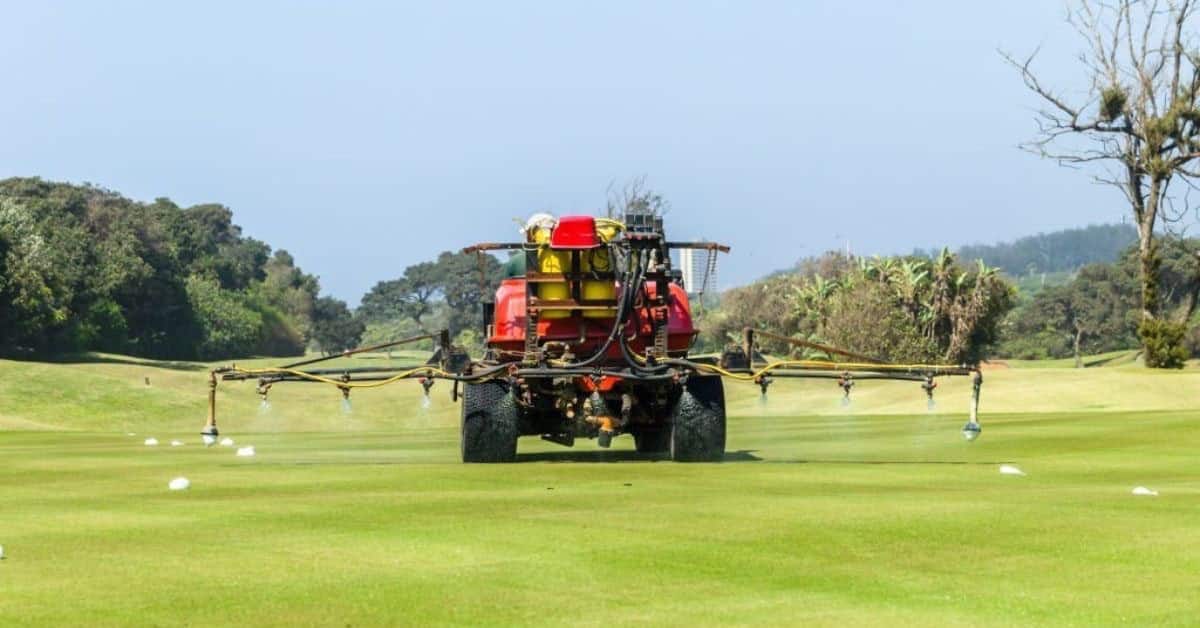As golfers, we have high expectations for the condition of the courses we play.
Picture the perfect golf course: immaculate tee boxes, luscious fairways, and dense greens with a firm — yet forgiving — roll.
Maintaining an attractive golf course requires a lot of work. And one essential tool for a greens team is fertilizer, designed to keep the grass healthy throughout the year.
In this article, you’ll learn everything about golf course fertilizer. From the types of fertilizer used, to the fertilizer schedule and the potential environmental impacts.
Ready? Let’s go!
Golf Course Fertilizer
Golf course fertilizer is used as a supplement to keep the turf healthy when the soil alone isn’t meeting its needs, encouraging growth and providing valuable nutrients. This helps the turf withstand environmental stresses such as foot and cart traffic, divots, pitchmarks, and adverse weather conditions.
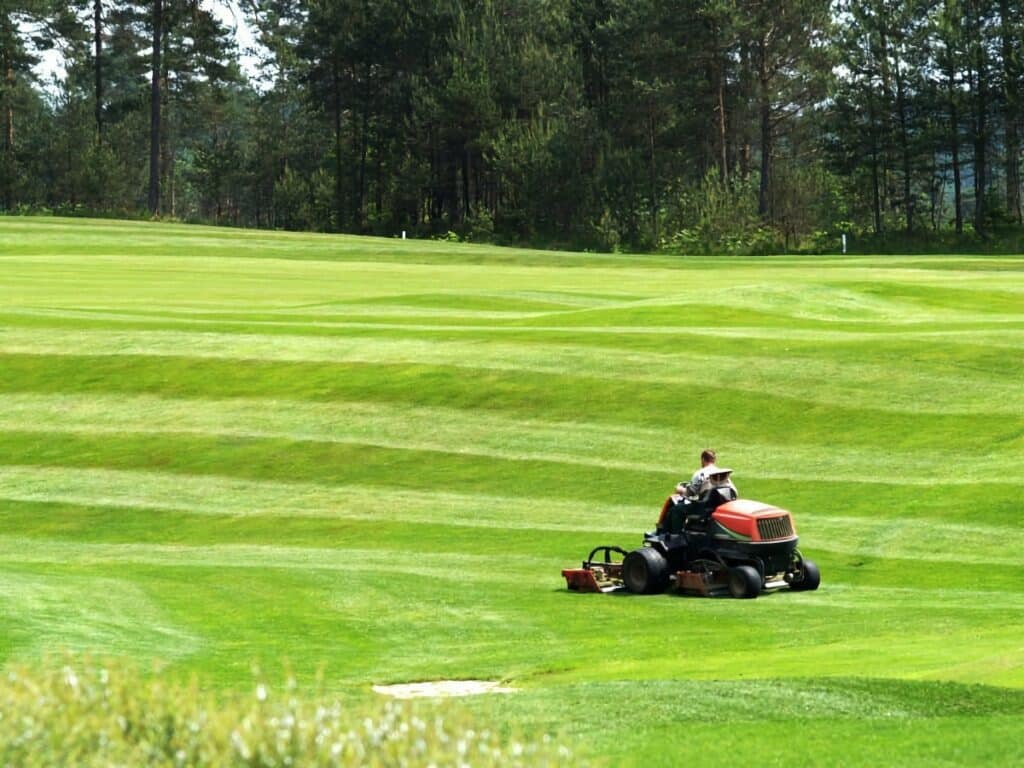
Why Do Golf Courses Use Fertilizer?
All plants have basic requirements for optimal growth: sunlight, water, and nutrients.
The turf on a golf course is no different!
Fortunately, sunlight is fairly abundant throughout the year. In areas lacking sunlight, the type of grass has adapted to lower light levels. And while there is a rainwater shortage in some locations, this can be balanced with the use of sprinkler systems.
That leaves nutrients — which are equally important:
Nutrients are critical for maintaining plant health throughout the year and directly impact golf course presentation and playability.
Typically supplied naturally via the soil, nutrients are often supplemented with fertilizers to maximize the turf quality and appearance of the golf course.
Turf Quality
Many golf courses receive heavy foot and cart traffic throughout the season. This puts significant environmental stress on the turf, causing it to die if not provided with the necessary nutrients to recover. Fertilizer improves turf quality by enhancing:
- Root growth
- Shoot growth
- Turf density
By providing turf with the necessary nutrients, it becomes stronger and denser. This helps it to withstand and recover from consistent traffic on the golf course.
This is particularly important on the greens, which receive more concentrated traffic than any other spot on the course. Maintenance teams perform other tasks like green aeration to help the turf recover and remain healthy in the long run.
Appearance
As well as improving the overall quality of the turf, nutrient-packed fertilizers help to maintain the appearance of the golf course. In particular, fertilizers help to give the turf a deep green color, which is synonymous with the highest quality courses.
However, according to the USGA: “Fertilizer should not be applied to produce a vibrant green color, but rather to encourage healthy turf that can recover from environmental stresses as well as golfer and maintenance traffic”.
So, fertilizers shouldn’t be used primarily for the appearance of the course. Instead, they should be used for turf growth, and appearance is a useful bonus.
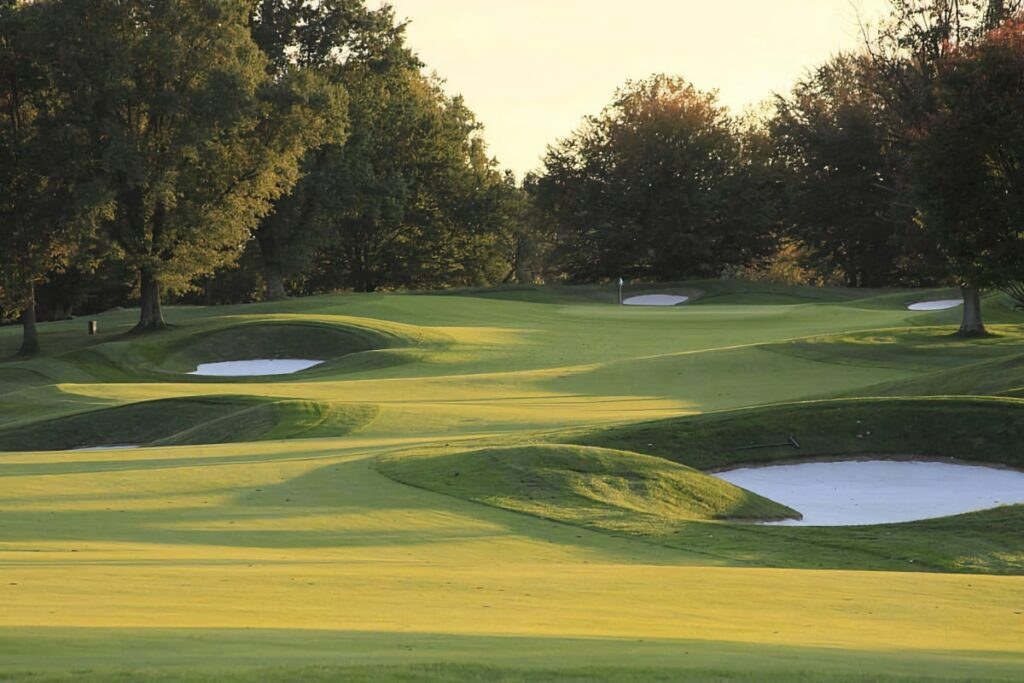
Fertilizer For Golf Courses
So, we’ve covered the main reasons golf courses use fertilizers to supplement turf with essential nutrients. But what are those nutrients?
Many golf courses use fertilizers with a blend of three elements essential for growth:
- Nitrogen — for plant growth and color
- Phosphorous — for root development
- Potassium — for overall plant strength
Nitrogen, phosphorous, and potassium are considered to be primary nutrients, and plants require them in much larger quantities than other essential nutrients.
Nitrogen
Essentially, nitrogen fertilizers are the primary component of turf nutrition programs.
Providing healthy leaf and stem growth, nitrogen helps to grow the best thick and strong grass all through the spring and summer months. At the same time, it helps give turf the deep green color that is associated with healthy grass.
According to the GCSAA: “the average 18-hole golf facility applies approximately 2 pounds of nitrogen per 1,000 square feet (97.6 kilograms per hectare) annually.”
Phosphorous
Phosphorous is another essential nutrient required for plant growth.
Importantly, phosphorous helps with root development, plant maturation, and seed development, helping plants grow and develop normally.
Put simply, phosphorous is linked to a plant’s ability to use and store energy.
Potassium
Potassium is the third key nutrient of commercial golf course fertilizers.
It helps strengthen the ability for plants to resist disease, improving the overall quality of the turf. Potassium also helps to protect the turf when the conditions are cold or dry, strengthening the roots and preventing wilt.
Many fertilizer blends combine these three elements in a granular form, along with additional micronutrients that benefit turf growth.
In the following video, Adam Champion of Bearspaw Golf Club discusses the importance of these nutrients, and the application process:
How Much Does a Golf Course Spend on Fertilizer?
Golf courses are expensive to build and operate!
According to research conducted by Golf.com, the average annual maintenance cost for 18-hole golf courses in the United States is $810,254.
Fertilizer is the second largest expense — only behind labor costs — and is responsible for 5.05% of the annual maintenance budget. This is equivalent to an average annual cost of $40,917 on fertilizer products alone.
Data from Turf Feeding Systems supports this, which states that “golf courses spend $25,000 to over $100,000 on fertilizer annually”. Premium courses sit at the top end of that bracket. Often, these will fertilize more frequently, keeping the course in top condition to attract higher green fees and membership rates.
Greens receive the highest proportion of fertilizer on the course. So, golf courses with larger greens will subsequently use more fertilizer than those with smaller greens.
The report by Golf.com also states that fungicides — the pesticide responsible for preventing or killing the growth of fungi — cost an average of $34,678 every year.
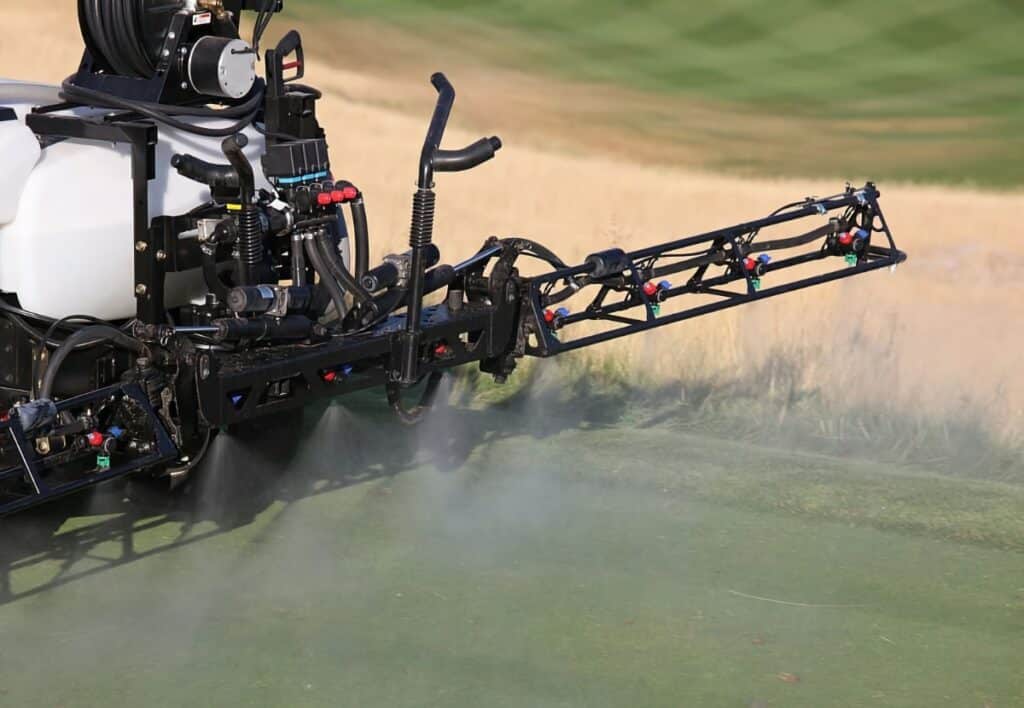
Golf Course Fertilizer Schedule
For many golf course operators, the fertilizer schedule varies depending on the area of the course — green, fairway, or rough — and the time of year.
Typically, golf course maintenance teams will fertilize the greens every two weeks. The greens often require more attention than any other part of the course, as they receive highly concentrated traffic over the course of the year.
On the other hand, fairways and tee boxes are usually fertilized twice per year — once in the spring, and again in the fall.
Likewise, the rough tends to receive fertilizer once or twice per year, depending on how it performs after a preliminary assessment.
| Fertilizer Applications Per Year | |
| Greens | Every 2 weeks |
| Fairways & tee boxes | Twice per year (spring and fall) |
| Rough | Once per year (spring or fall) |
Check out this article for a comprehensive look into how often golf courses fertilize.
What Is Overfertilization?
Although fertilizers have many benefits for turf health, overfertilizing is undesirable. It can stimulate the growth of leaves and stems — especially with nitrogen.
This is unwanted, as it makes the turf more susceptible to pests, damaging the integrity of the turf by making it less resilient to stress. Over time, this can cause the turf to thin, which is more open and prone to weeds germinating and establishing.
Also, pest infiltration can result in large, unsightly areas of discoloration in the turf.
Fortunately, pesticides can be used to prevent and repair damage caused by insects. However, some pesticides can have negative environmental impacts. Read on to learn about the potential negative side of misusing fertilizers and pesticides.
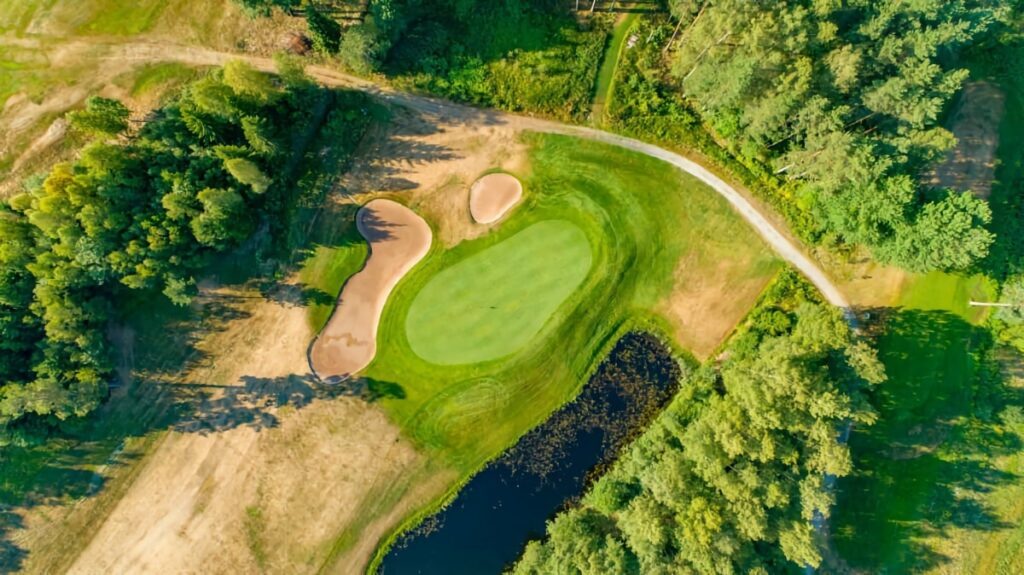
Golf Course Fertilizer Pollution
The risk of pollution via golf course fertilizer runoff has been discussed for many years.
In the Toxic Fairways study of 1995, the research found that golf course workers are at risk of higher mortality rates from specific cancers. In addition, it highlighted concerns that pesticide drift — the process of particles becoming airborne and landing on neighboring sites — could affect nearby residents.
However, despite these potential risks, fertilizers and pesticides are safe to use on golf courses if distributed and applied with care.
Most importantly, maintenance staff should be well-prepped about the risks associated with fertilizers and pesticides before using them. For instance, misuse on the golf course can cause fertilizer runoff, so tarmac cart paths should be avoided.
“Precise application and proper timing avoids excessive flushes of growth, reduces the risk of runoff or leaching and ultimately provides an enjoyable player experience.”
— USGA
In addition, golf courses are often expected to close chemically treated areas of the course for a period of time — during and after spray — to prevent public contact.
Today, many courses avoid the overuse of artificial chemicals, instead opting for organic slow-release alternatives such as Milorganite.
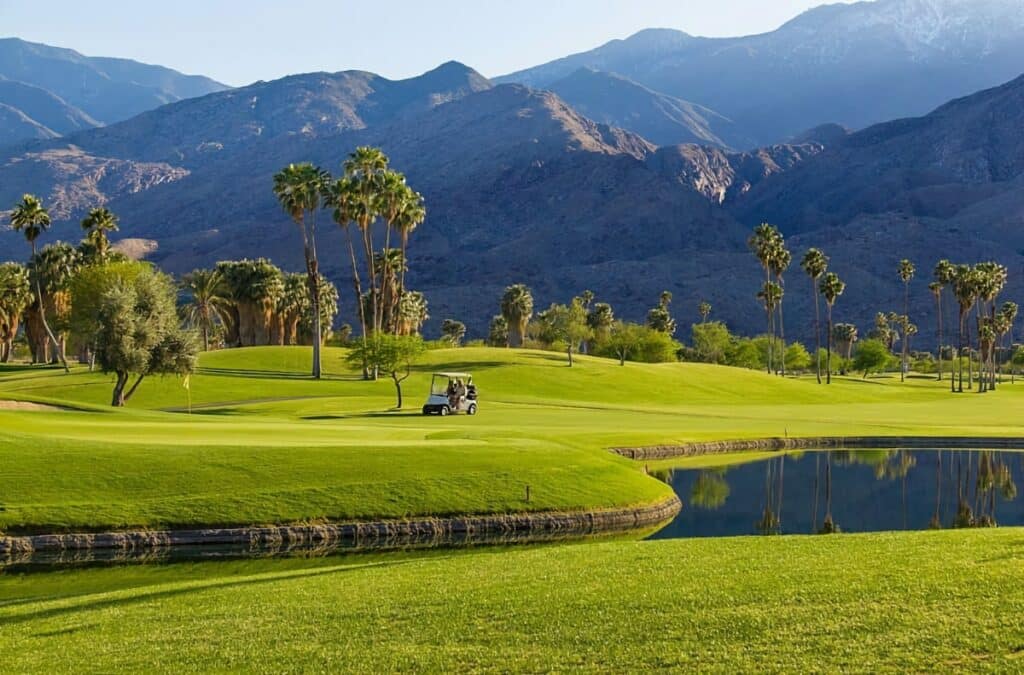
Conclusion
In summary, fertilizer is an essential tool for many golf courses. Usually, the natural soil found at golf courses lacks the essential nutrients required to support turf — which undergoes environmental stresses such as repeated divots and heavy foot traffic.
The main nutrients in fertilizers are nitrogen, phosphorous, and potassium. And, many fertilizer blends combine these three elements in a granular form, along with additional micronutrients that benefit turf growth.
While toxic fertilizers have proven problematic in the past, many golf courses are using organic alternatives which minimize environmental impact.
Ultimately, fertilizers are a vital supplement for the golf course, serving the keep turf healthy year-round while maintaining an attractive appearance.

